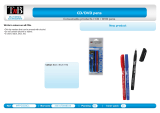
a
To draw on images from a document camera, select Camera on
the Home screen, or [
] from the Command Bar. The
image from the document camera is displayed on the Camera
screen.
s "Camera Screen" p.17
b
Select [ ] on the Drawing Toolbar.
c
Draw on the projected image.
a
To change the color and thickness of the pen lines, select
[
] next to [ ] to display the pen palette.
Once you have selected the color and thickness, select [
] to
close the pen palette.
d
To erase drawings, select [ ] or [ ] from the Drawing
Toolbar.
• When you select [
]: You can use the interactive pen as an
eraser.
• When you select [
]: All of the current drawings are erased.
e
To save the content of your drawing, select [ ] from the
Command Bar.
You can save the displayed screen in JPG, BMP, PNG, PDF, or EIT
format.
You can set the save location, file name, and the file format on the
Save Settings tab on the Settings screen.
s "Save Settings tab" p.20
a
If you open an EIT file on another computer that has a
different display resolution, some parts of the drawings may not
be displayed.
Operating a mouse from the projected image (mouse operations)
When you select [ ] from the Drawing Toolbar in Annotation mode,
you can operate the computer from the projected image (mouse
operations).
When mouse operations is activated, you can use the interactive pen to
perform operations such as click, right-click, and drag & drop.
• Click: Press and remove the pen tip from the projected image.
• Right-click: Press the right button on the interactive pen, or hold the
pen tip to the projected image for a few seconds and then remove the
pen tip from the image.
• Drag & drop: Press the pen tip to the icon or object that you want to
move, drag the pen tip to where you want to move the object, and then
remove the pen tip from the projected image.
a
• You cannot use the drawing functions when performing mouse
operations.
• To use the drawing functions, select [
] again.
Basic Operation
10





















